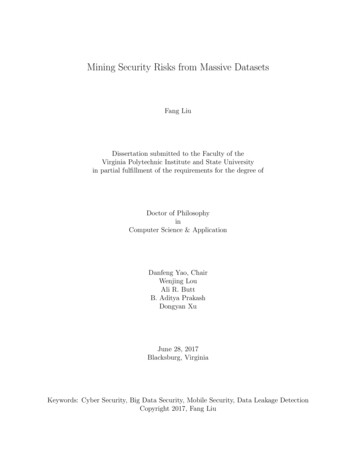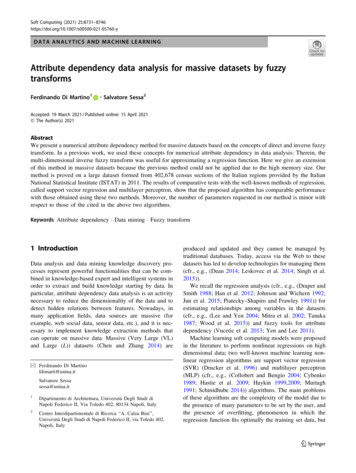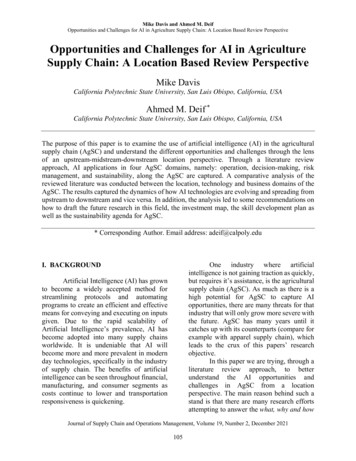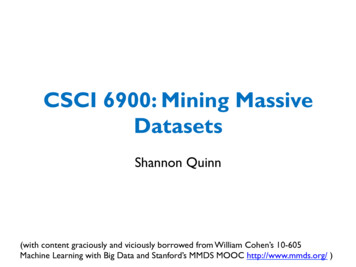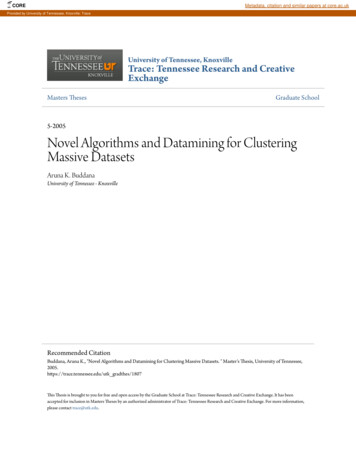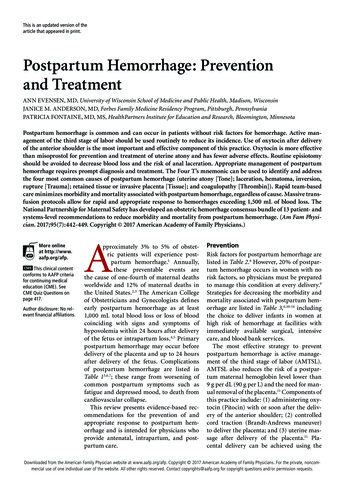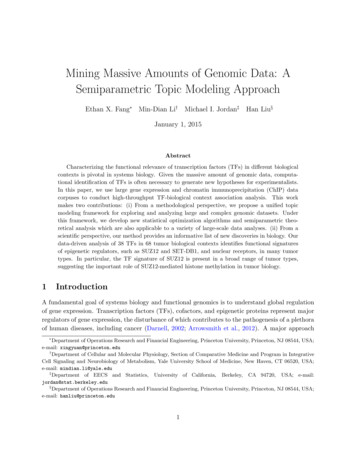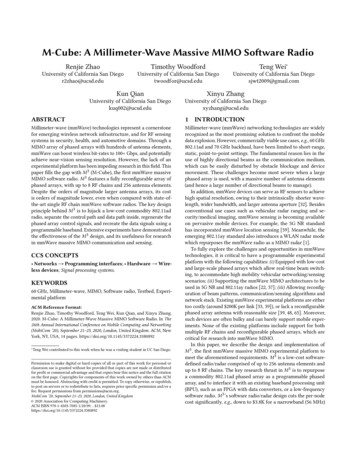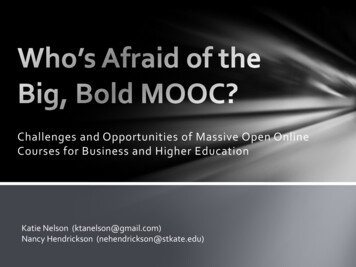
Transcription
Challenges and Opportunities of Massive Open OnlineCourses for Business and Higher EducationKatie Nelson (ktanelson@gmail.com)Nancy Hendrickson (nehendrickson@stkate.edu)
MOOC Definition
MOOC DefinitionA massive open online course is an online course aimed atunlimited participation and open access via the s.wikimedia.org/wiki/File%3AMOOC poster mathplourde.jpgImage licensed underthe Creative CommonsAttribution 2.0 Genericlicense.
TRUE or FALSE? (pretend to have a clicker!)1. MIT now includes space for students to list their MOOCs inadmission applications.TRUE2. Approximately 75% of undergraduate students are familiarwith MOOCs.FALSE3. Instructure and Blackboard are adding a MOOC platform toTRUEtheir LMSs.4. Moody Investors Services designated MOOCs as a "creditpositive" for prominent universities that offer MOOCs. TRUE5. About 60% of university presidents strongly view MOOCsas having “"great potential to make a positive impact." m-mooc-perspectives-research-andresources?utm source Informz&utm medium Email marketing&utm campaign EDUCAUSEECAR's Study of Undergraduate Students and Technology, 20133 EDUCAUSE Center for Applied Research (ECAR)
AGENDA1. Big MOOC Numbers2. Bold MOOC Opportunities &Challenges3. Questions to Ask4. Activity – Read & Share5. Large Group DiscussionImage 2014 Microsoft Corporation
Growth of MOOCsFrom April, 2012 to October, 2013http://edutechnica.com/moocmap/
Number of MOOCsAs of January 10, 2014:1369 MOOCsConducted More Courses More Students More 090090d356c7bd2615e8d.jpg
Number of MOOCsAs of January 10, 2014:1369 MOOCsConducted More Courses More Students More 090090d356c7bd2615e8d.jpg
Major PlayersHave included faculty frommany Universities world-wide.However Participation has beenprimarily via invitation /partnership agreements only.SEARCH for MOOCs m/NEW in 2013: FutureLearn, Open2Study,iversity, EduKart and France UniversitéNumerique
Getting into the ActNo Way to Host a MOOC of Your Own?Don’t worry, MOOC.ORG is on the Way!http://mooc.org/“mooc.org goes live in the first half of 2014.mooc.org is an edX destination. We're working to helpeducational institutions, businesses and teachers easilybuild and host courses for the world to take.”
EdX(non-profit)STARTED BY: Harvard and the Massachusetts Institute ofTechnology createdSTART DATE: May 2012COURSES: physics, computer science, engineering, literature,ethics, law, medicine and economicsUNIVERSITIES in PARTNERSHIP: 29 including the University ofCalifornia, Berkeley; the University of Texas, Austin; Georgetown;Cornell; the Berklee College of Music; the University of Toronto; andthe University of KyotoWORKLOAD: Varies widely Global History of Architecture from M.I.T. -- 5 hours per week Introduction to Computer Science from Harvard: 8 problem sets @15-20 hrs each plus two quizzes and a final online-course.html
Coursera (for profit)STARTED BY: Two Standford professors, Andrew Ng and Daphne KollerSTART DATE: April 2012COURSES: physics, computer science, engineering, literature, ethics, law,medicine and economics400 free college-level courses offered to more than four million studentsfrom every country in the worldUNIVERSITIES in PARTNERSHIP: 84 Universities including Stanford,Princeton, University of Pennsylvania, University of Michigan, Yale, Duke,University of Chicago, University of EdinburghPATH FORWARD: Hope to earn money in other ways, such as linkingcorporations to skilled -online-course.html
Udacity (for profit)STARTED BY: Sebastian Thrun, David Stavens, and Mike SokolskySTART DATE: January 2012COURSES: 30 – Focused on: Science, math and computer scienceCOURSE LENGTH: Entirely SELF-PACED with no enforced start/end datesCOURSE METHODS: Courses are built around hands-on projects that can beshown to employers as part of a f-online-course.html
MOOC Opportunities1. Free or Inexpensive2. Accessible to Many3. Courses from Well-Known Field Leaders4. Can Document New Learning in Own Way
MOOC Challenges1. Overly Prescriptive – is it a Form of Neocolonialism?2. One-size-fits-all Approach3. Primarily a Western Approach -- doesn’t allow foralternative and non-Western perspectives4. Encourages Passive Learning5. Large Numbers Challenge Active Participation6. Learners Learn Best from Other Humans -- MOOCsoften don’t Encourage or Provide Avenues7. High Attrition Rates & Low Completion Rates8. Copyright Issues - Acad. I.P. Rights & Student Data
MOOC Challenges: Attrition Rates“Attrition rates ofactive users (thosethat come into thecourse and dosomething, not justthose who .co.uk/no good tml
MOOC Challenges: Completion RatesThis is preliminary datathat is part of Gatesfunded research onMOOCs.Martin Weller islooking at learningdesignanalysis, while KatyJordan is lookingat factors influencingcompletion rates.Martin Weller: Professor of Educational Technology at the Open University in the UKhttp://nogoodreason.typepad.co.uk/no good reason/2013/12/completion-data-for-moocs.htmlThis work is licensed under a Creative Commons Attribution-Noncommercial-Share Alike 2.0 UK:England & Wales License.
Research is Starting to Come InMore dedicated research findings are beginning to surface:Harvard papers - here, the MIT papers hereImage 2014 Microsoft Corporation.
Research is Starting to Come In 841,687 people registered for the 17 MOOCs from Harvard andMIT. 5 percent of all registrants earned a certificate of completion. 35 percent never viewed any of the course materials. 54 percent of those who “explored” at least half of the coursecontent earned a certificate of completion. 66 percent of all registrants already held a bachelor’s degreeor higher. 74 percent of those who earned a certificate of completionheld a bachelor’s degree or higher. 29 percent of all registrants were female. 3 percent of all registrants were from underdevelopedcountries.
Research is Starting to Come In 841,687 people registered for the 17 MOOCs from Harvard andMIT. 5 percent of all registrants earned a certificate of completion. 35 percent never viewed any of the course materials. 54 percent of those who “explored” at least half of the coursecontent earned a certificate of completion. 66 percent of all registrants already held a bachelor’s degreeor higher. 74 percent of those who earned a certificate of completionheld a bachelor’s degree or higher. 29 percent of all registrants were female. 3 percent of all registrants were from underdevelopedcountries.
Research is Starting to Come In 841,687 people registered for the 17 MOOCs from Harvard andMIT. 5 percent of all registrants earned a certificate of completion. 35 percent never viewed any of the course materials. 54 percent of those who “explored” at least half of the coursecontent earned a certificate of completion. 66 percent of all registrants already held a bachelor’s degreeor higher. 74 percent of those who earned a certificate of completionheld a bachelor’s degree or higher. 29 percent of all registrants were female. 3 percent of all registrants were from underdevelopedcountries.
Research is Starting to Come In 841,687 people registered for the 17 MOOCs from Harvard andMIT. 5 percent of all registrants earned a certificate of completion. 35 percent never viewed any of the course materials. 54 percent of those who “explored” at least half of the coursecontent earned a certificate of completion. 66 percent of all registrants already held a bachelor’s degreeor higher. 74 percent of those who earned a certificate of completionheld a bachelor’s degree or higher. 29 percent of all registrants were female. 3 percent of all registrants were from underdevelopedcountries.
Failure Precipitates MOOC SuspensionAfter finding half of the students failed their MOOCs , San JoseState University has recently suspended their MOOCs withUdacity. acity-mooc-hiatus-a-crisis-of-rhetoric/San Jose MOOC Pass/Fail RatesPassing StudentsFailing Students
Student Experience – Quality?How do we determine what isbest for the student?* Quality of instructional design cMOOCvs. xMOOC Learning Strategies Learner performance Cost to the learner Accessibility Acquiring online collaborationmethods & resources used intoday’s workplace*List of factors compliments of Carole Bagley
Competency-based Programs2013 DOE Decision Opened the DoorU.S. Department of Education’s March 2013endorsement of competency-based education,EXAMPLE: Western Governor’s University“ accelerate your program (and save money) . youare able to complete your degree program as soon as youcan successfully complete all of the necessaryassessments. Since tuition is charged at a flat rate everysix months—you pay for time, not per credit hour—ifyou’re able to finish faster, you can save both time andmoney.”http://www.wgu.edu/why WGU/competency based approach
BadgesDefinition: Symbol or indicator of anaccomplishment, skill, competency, or interestImportant Factors The issuer of the badge How the badge was earned and when Links back to artifacts, documents, or testimonialsdemonstrating the work that lead to earning the badge Authentication back to the issuer and relevantstandards bodieshttp://www.openbadges.org/faq/
FlexPath SchedulingNEWLY Accredited with programs debuting in 2013 fromCapella (BADM & MBA) and the University of Wisconsin(Six programs – Associate & rch2.capella.edu/?q Flexpathg
Sparking QuestionsFrom Educause’s “7 THINGS YOU SHOULD KNOW ABOUT MOOCs”June 11, 2013Perhaps the MOOC’s most important contribution to datehas been to raise important questions andspark essential conversations -you-should-know-about-moocs-ii
General MOOC Questions1. Where do you think MOOCs will be in five years?2. Are MOOCs of value in the arena in which you work?3. If MOOCs were improved, could they hold more value?4. How do you think they could be improved?5. Where do MOOCs have a place in the constellation ofknowledge and resources in your work environment?6. How should learning be assessed, ideally?
Questions - Business1. What constitutes a valid learning experience thatcan be accepted in the work place?2. What kind of documentation is needed?3. Should that documentation be expressed as a“grade” or “credit/hours” or “competencies”?4. Would your workplace benefit from partneringwith ? to offer MOOCs as part of your employeeprofessional development? Who would/could youpartner with?
Questions – Education1. Are MOOCs / Badges affecting your institution’senrollment or economic picture? How?2. Are MOOCs / Badges a valid or ethical way to drawstudents into existing regular degree programs?3. What constitutes a valid learning experience thatshould be offered by institutions or accepted for“credit?”4. Should components from existing MOOCs be incorporated into your school’s curriculum?
http://padlet.com/wall/asm728eurp
Changed Perceptions?
5 percent of all registrants earned a certificate of completion. 35 percent never viewed any of the course materials. 54 percent of those who "explored" at least half of the course content earned a certificate of completion. 66 percent of all registrants already held a bachelor's degree or higher.

